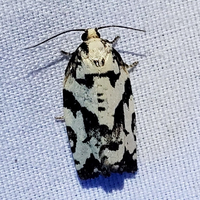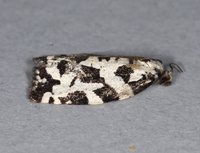Identification
Adult Markings: This is a distinctive species with a boldly marked black-and-white forewing. The following description is based in part on that of Freeman (1958). The head, thorax, and ground of the forewing are pure white, and the forewing ground is overlain with several black marks. The wing base has a highly irregular black line that extends inward on the inner margin at about one-fifth, then angles -- often in stair-step fashion -- near the middle of the wing before angling again towards the wing base. A jagged, posteriorly-oblique black median band extends from the costa to the inner margin that usually has a spur that projects posteriorly from the sub dorsal region. Between the median band and the basal line there are usually one or two short, black striae on the inner margin. A semi-oval black costal spot is present at around three-fourth that often has one or two white dots within. The final mark is an irregular black band or patch that covers much of the subterminal region of the wing. The fringe is smoky black, and the hindwind uniformly smoky black with a similar colored fringe. The costal fold of the male is long and narrow, and has long scales on the posterior end.
Wingspan: 19-22 mm (Freeman, 1958)
Adult Structural Features: Freeman (1958) has images and descriptions of the male and female genitalia.
Adult ID Requirements: Identifiable from good quality photos of unworn specimens.
Immatures and Development: The larval life history has not been reported.
Larvae ID Requirements: Identifiable only through rearing to adulthood.

 »
»


 »
»
